A Background of Oil and Gas Development in Colorado
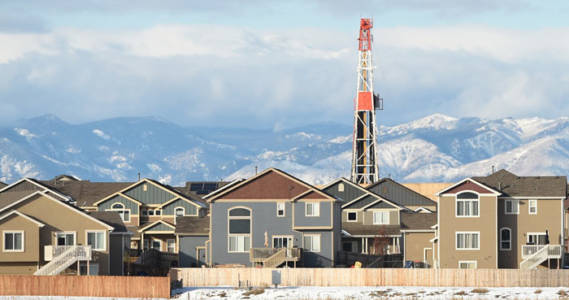
Neighborhood fracking in Colorado
In the 20th Century, most oil and gas production in CO was done through conventional wells drilled vertically, with the ‘nodding donkeys’ to pump up the fuel.
The practice of fracking (or hydraulic fracturing) and horizontal drilling exploded around 2008 after a national energy bill passed in 2005 that exempted hydraulic fracturing from the Safe Drinking Water Act, so that the US EPA does not regulate the injection of fracturing fluids under the Act.
Fracking is a heavy industrial process whereby millions of barrels of water are mixed with hundreds of undisclosed and often toxic chemicals and then injected into the earth under extremely high pressure to force oil and gas (methane) to the surface. Research and on the ground experiences have proven that fracking poses grave risks to public health, clean air and water, and a stable climate.
The oil and gas industry is the only industry in America that is allowed by the EPA to inject known hazardous materials — unchecked — directly into or adjacent to underground drinking water supplies. This exemption from the SDWA has become known as the “Halliburton loophole” because it is widely perceived to have come about as a result of the efforts of Vice President Dick Cheney’s Energy Task Force.
Before taking office, Cheney was CEO of Halliburton — which patented hydraulic fracturing in the 1940s, and remains one of the three largest manufacturers of fracturing fluids. Halliburton staff were actively involved in the review of the 2004 EPA report on hydraulic fracturing, which claimed that fracking ‘poses little or no threat’ to drinking water. Colorado’s own Wes Wilson was an EPA whistleblower, calling the study “scientifically unsound”.
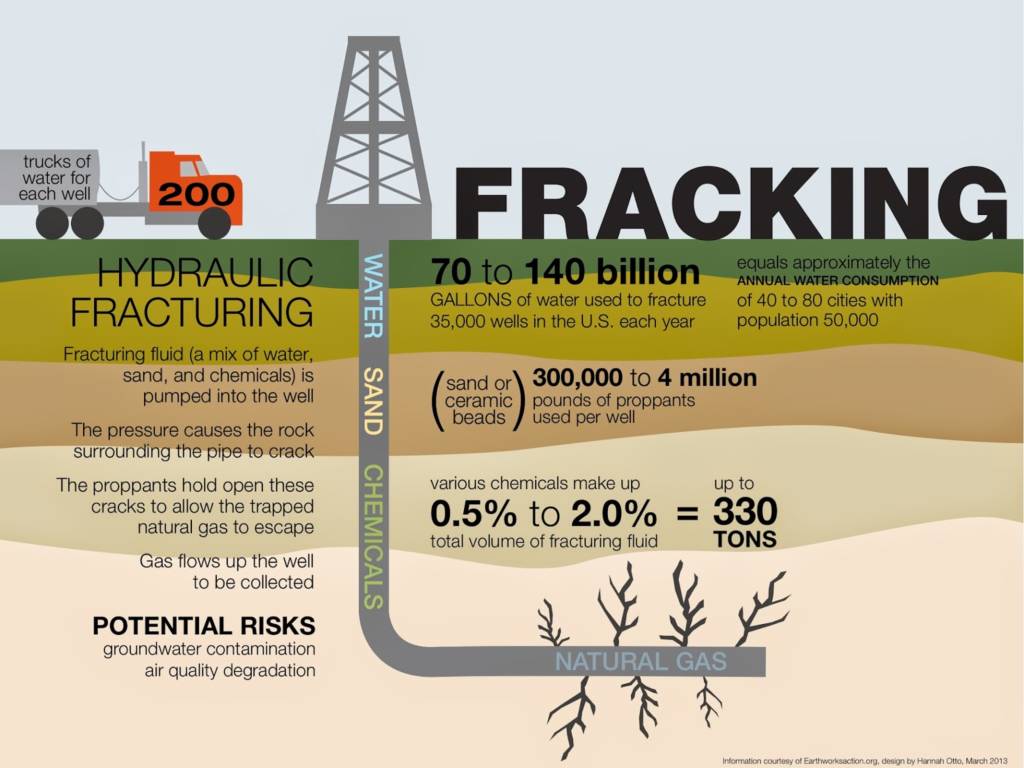
http://coloradofracking.blogspot.com/
The Harms of Fracking
Fracking is fueling the flames of the climate crisis. In a time when the world’s scientists tell us that we must rapidly reduce fossil fuel production to keep global temperatures below 1.5C, Colorado has continued permitting, with over 5600 additional fracking wells approved since Gov. Polis came into office. The Oil & Gas industry is the #1 source of Colorado’s GHG emissions – by far when you consider the emissions from oil and gas exports. 90% of the oil and 66% of the gas produced in Colorado is exported out of state.
 Studies by NOAA and other researchers have shown vast leakage of methane – a potent greenhouse gas – from fracking well-heads directly into the atmosphere. They have documented approximately 4% methane gas leakage rates in the Denver-Julesberg Basin and much higher in other regions, leading many to consider fracking as dangerous to our climate as burning coal—if not more so. 1
Studies by NOAA and other researchers have shown vast leakage of methane – a potent greenhouse gas – from fracking well-heads directly into the atmosphere. They have documented approximately 4% methane gas leakage rates in the Denver-Julesberg Basin and much higher in other regions, leading many to consider fracking as dangerous to our climate as burning coal—if not more so. 1
The climate crisis is already causing billions of dollars of damages to Colorado, harming the agriculture and recreation industries and causing disasters, like the Marshal fire that happened just over a year ago – the most destructive yet in Co’s history. Climate-caused disasters have cost the state between $20-50 billion since 1980.
The negative impacts of fracking on people living on the frontlines are well known. Toxic emissions, chemical spills, negative effects on human and animal health, water and air contamination, decreasing property values and other harmful impacts from this industry are well documented. For example:
- The oil and gas industry is the #1 cause of the ‘severe’ ozone nonattainment along the Front Range. This air quality crisis is known to increase the risk of asthma, heart attacks, dementia and premature death. The industry’s releases of volatile organic compounds (VOC) and Nitrogen Oxides (NOX), lead to dozens of deaths in Colorado each year.
- Researchers have found that pregnant women living within two-thirds of a mile of a hydraulic fracturing well were 25% more likely to give birth to a worryingly small infant than were women who lived at least 10 miles outside that zone during pregnancy. Over these babies’ lifetimes, their low birth weights raise the likelihood they will suffer poorer health and lower achievement, including reduced earnings and educational attainment. Read the study here.
- There is clear evidence from numerous studies that toxic air emissions, such as carcinogenic benzene, near fracking put nearby residents at increased risk of cancer.
- According to the TEDX The Endocrine Disruption Exchange, many of the hundreds of chemicals used in oil and gas operations have been shown to have severe impacts on wildlife and human health, including the respiratory, digestive, immune, reproductive and nervous systems.
- A TEDX analysis of 353 of the 632 chemicals used during oil and gas operations found that more than 75% of the chemicals could affect the skin, eyes, and other sensory organs, and the respiratory and gastrointestinal systems. Approximately 40-50% could affect the brain/nervous system, immune and cardiovascular systems, and the kidneys; 37% could affect the endocrine system; and 25% could cause cancer and mutations.
- The incessant noise, vibration, toxic fumes and worries about permanent health harms to family members also causes sleeplessness, stress and mental health concerns for many living near fracking.
Colorado Fracking Water Impacts
- Fracking uses 1-16 million gallons per well and the water is made so toxic and radioactive that it is not economical to restore it – it is taken out of the water cycle, 2 usually injected into deep injection wells that frequently cause earthquakes. This loss of precious fresh water is of grave concern as the climate crisis further dries out our semi-arid region and our population increases.
- Research has shown that 30-40% of oil spills in the Greater Wattenberg Area of the Denver-Julesburg Basin resulted in groundwater contamination from 2007-2014.
- Over a 3 year period in Colorado, more than 1,000 fracking-related spills of diesel fuel, oil, toxic chemicals, and other contaminants, dozens of which have polluted groundwater, were documented.1
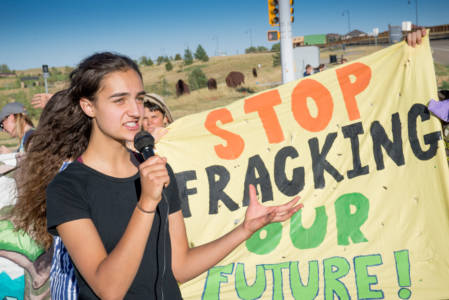
Youth activist Maya Beauvineau speaks out against fracking
Fracking has many other negative impacts as well, such as lowered property values near drilling sites, harms to wildlife and ecosystems, habitat fragmentation and costs related to remediating and plugging abandoned oil and gas wells, much of which is paid for by Coloradans instead of the companies that made the mess. A 2022 report by Carbon Tracker estimated that Coloradans could be on the hook for as much as $7B to clean up orphaned and abandoned wells as increasing numbers of companies go bankrupt.
Since 1998, over 122,000 wells have been drilled in Colorado. Every one of those wells will likely leak methane and toxic chemicals into water and/or air over time and have to be recapped every 20 or so years as the concrete and other materials break down. This will be a major ongoing challenge and expense to future Coloradans.
Federal and state regulations have failed to protect the health, safety and well being of Colorado communities.
Facing all of the known dangers of fracking, the movement to protect our communities from fracking has grown over the years, pushing back against the oil and gas industry’s plans to place thousands of wells next to homes, schools, public parks, and pristine areas in our state. Our calls for help from elected officials and regulators have unfortunately largely been ignored, as the industry boasts the largest number of lobbyists at the State Capitol and wields its money and power to influence too many overly-ambitious politicians.
History of the Anti-Fracking Movement in Colorado
Between 2010-2015, Longmont, Ft. Collins, and 4 other communities passed local fracking bans and moratoria to protect themselves, but then-Governor John Hickenlooper’s administration joined with the industry in a lawsuit against these communities. In May of 2016, the CO Supreme Court ruled that the State has preemption over local communities and overturned the bans and moratoria.

Coloradans Against Fracking at a COGCC meeting
In 2016, people fought for 2 statewide ballot initiatives (75 and 78) to restrict fracking in Colorado by allowing local community control of fracking and increasing setbacks (buffer zones) from wells to homes, schools, and waterways to 2500 feet. The oil and gas industry spent millions of dollars fighting the initiatives, which despite receiving enough signatures to get on the ballot, had too many thrown out by the Secretary of State’s Office and thus failed to make the ballot. The oil and gas industry then primarily funded ballot initiative 71, which made it far more expensive and difficult to pass ballot initiatives in the future.
In 2013, the Earth Guardians youth group petitioned the COGCC to promulgate a rule requiring that COGCC withhold issuance of new drilling permits “unless the best available science demonstrates, and an independent, third party organization confirms, that drilling can occur in a manner that does not cumulatively, with other actions, impair Colorado’s atmosphere, water, wildlife, and land resources, does not adversely impact human health, and does not contribute to climate change.” The COGCC refused to undertake the proposed rule-making, saying the proposed rule was beyond their statutory scope.
In March of 2017, in the Martinez vs. COGCC decision, the Colorado appeals court said that the state must protect health and environment before allowing oil and gas drilling, siding with youth plaintiffs, saying the protection of public health and the environment is “a condition that must be fulfilled”. Unfortunately, on January 14, 2019, the Colorado Supreme Court overturned that decision, saying the COGCC appropriately exercised its agency discretion when it declined to undertake the rulemaking.
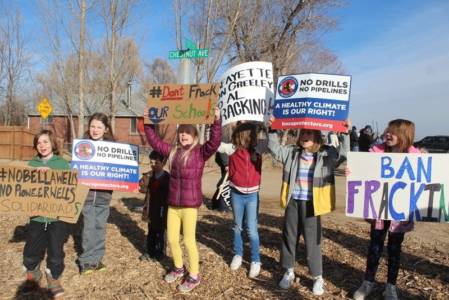 On May 2, 2017, an Anadarko well which had an open gas line venting gas under a house in Firestone caused it to explode, killing two brothers-in-law and seriously injuring a mother, and a child in the home had to jump from a second story window to escape. Neighborhoods have been built on top of abandoned and improperly mapped oil and gas infrastructure, creating serious dangers. Fires and explosions at well sites have also killed, burned and maimed numerous workers, who are mostly non-unionized, with insufficient protections and low pay, for example derrick operators median pay is $39,750.
On May 2, 2017, an Anadarko well which had an open gas line venting gas under a house in Firestone caused it to explode, killing two brothers-in-law and seriously injuring a mother, and a child in the home had to jump from a second story window to escape. Neighborhoods have been built on top of abandoned and improperly mapped oil and gas infrastructure, creating serious dangers. Fires and explosions at well sites have also killed, burned and maimed numerous workers, who are mostly non-unionized, with insufficient protections and low pay, for example derrick operators median pay is $39,750.
In 2018, Colorado Rising successfully placed Proposition 112 for a 2,500’ safety zone on the ballot, securing 1 million votes from around the state. The initiative lost with ~45% of the vote after the industry spent over $40M blanketing the airwaves and media with propaganda that a 2500’ safety zone would destroy jobs and the economy.
Meanwhile, since 2015, the industry has lost about half of the number of jobs due to the boom and bust nature of the industry, decreasing investor confidence and automation. Reports have shown that oil and gas-dependent communities have been the slowest to bounce back after the 2020 economic downturn.
Knowing that lives were on the line, pressure was also put on state legislators to reform fracking regulations, and the movement celebrated passage of SB19-181 in 2019, changing the mission statement of the COGCC so that it was no longer to ‘foster’ oil and gas development, and was instead simply to regulate the industry in such a way to protect public health, safety, the environment and wildlife.
The COGCC undertook rulemakings to fulfill its new mission, including setting a new safety zone of 2000’ between oil and gas operations and occupied buildings, but unfortunately there were loopholes, and numerous oil and gas wells continue to be permitted just a few hundred feet from homes.
Community leaders and members have pleaded with the COGCC to stop massive Comprehensive Area Plans with hundreds of wells, many within the 2000’ safety zone of homes, and been ignored. Over 5600 wells have been permitted since Polis was elected and over 4500 since SB 181 was passed. Only 1 permit has been denied. The legislature should use its authority to assess if the intent of SB19-181 is being fulfilled or ignored by the COGCC.
The oil and gas wars in Colorado are NOT over.
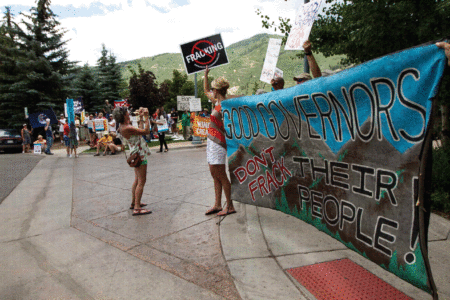 People are still fighting to protect their health, safety – their lives. Parents still watch their children become nauseous and get bloody noses and worry about potential long-term health impacts from exposures to benzene, such as leukemia and other cancers. Expectant mothers still fear for impacts to their unborn babies. Communities are experiencing worsening ozone and wildfires, knowing that the oil and gas industry is the #1 cause of emissions causing both our air quality and climate crises. And still, the Polis’ administration’s COGCC and AQCC continue to permit hundreds of additional permits every year.
People are still fighting to protect their health, safety – their lives. Parents still watch their children become nauseous and get bloody noses and worry about potential long-term health impacts from exposures to benzene, such as leukemia and other cancers. Expectant mothers still fear for impacts to their unborn babies. Communities are experiencing worsening ozone and wildfires, knowing that the oil and gas industry is the #1 cause of emissions causing both our air quality and climate crises. And still, the Polis’ administration’s COGCC and AQCC continue to permit hundreds of additional permits every year.
Colorado currently ranks #4 in the US based on Barrels of Oil Equivalent (BOE) produced, as of Sep 2022. In other words, the state of Colorado and the CDPHE are allowing serious contributions to the climate crisis, despite passage HB19-1261 and our leaders’ proclaimed efforts to do our part. In fact, the Polis administration’s GHG Emission REduction Roadmap models and allows for an increase in oil and gas production through the year 2030! When the world’s climate scientists say we must rapidly reduce fossil fuel production, it is irresponsible and unconscionable to increase or even continue the same rates of oil and gas extraction. Colorado must do its part and begin rapidly reducing and phasing out oil and gas permitting and focus efforts on a just transition for the workers and communities currently most dependent on the industry, so they can lead Colorado’s transition to clean, renewable energy.
Coloradans will continue to take a stand for the health and safety of our communities. This is our Colorado, and we must preserve our right to protect our families, properties and way of life. The oil and gas wars will only be over when Coloradans no longer have to fight to protect our health, safety, environment and our climate.
Over 60 organizations, community leaders and businesses and 1500 Coloradans so far have signed onto the open letter of support for a phase out of oil and gas permitting by 2030 and a just transition to a clean, renewable energy future. We urge everyone to sign on today at www.safeandhealthyco.org, share it with your friends, and call on your state and local leaders to join you!
Because the oil and gas wars will only be over, when the permits for more fracking stop.
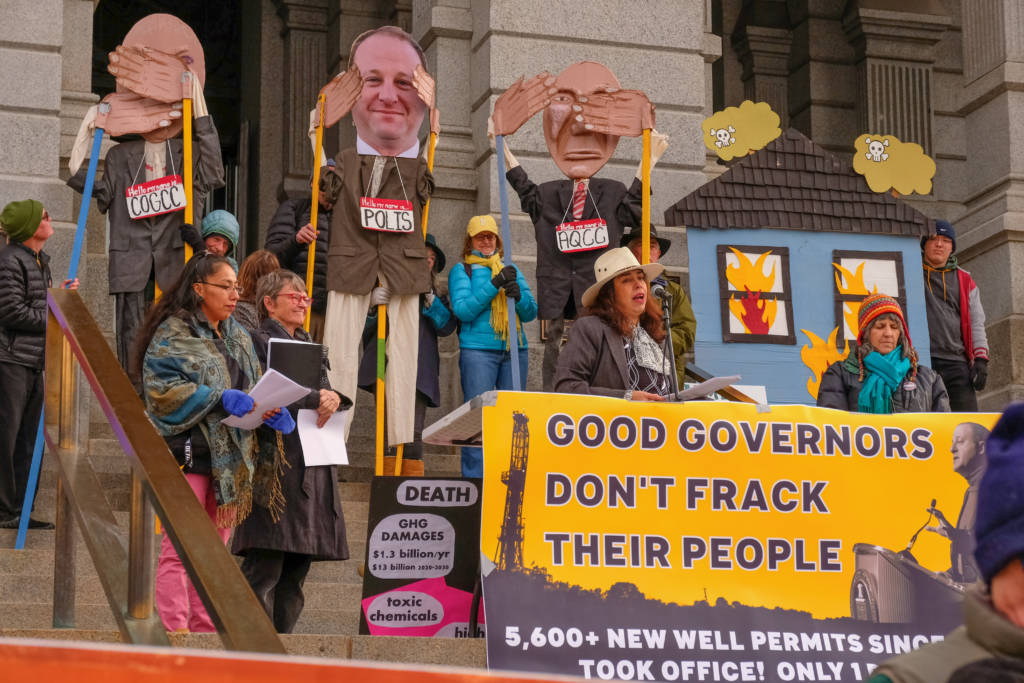
Lucy Molina speaks at the 2023 ‘Frack of the State’ Rally at the Denver Capitol
